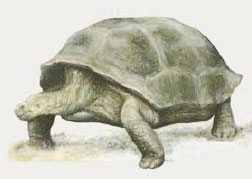
Illustration by Jason Bourque
Drying waterholes, baked brown grasses, and the ever-blowing hot wind greeted us, as my wife Shelley and I pushed our dust-coated car down the dirt roads toward Toadstool Park. We drove from Florida to this desolate corner of Northwestern Nebraska to collect fossil tortoises (add in time element here) for the Florida Museum of Natural History.
Like previous trips, we planned to hunt fossil tortoises in badland exposures on a private ranch along the Sand Creek valley. We would spend the summer in the tan, green and white mudstones, sandstones and volcanic ashes of the Chadron and Brule formations, collectively known as the White River Group. Florida Museum field crews had previously found shell fragments for as many as six species of tortoises at Sand Creek.
Shelley and I hoped to find key fossils that would show us how tortoises were adapting to changing environmental conditions associated with the spread of tropical savannas across the mid-continent of North America in the late Eocene and early Oligocene epochs, some 30 to 35 million years ago.

Photo by Richard Franz
We eyed hundreds of feet of exposed sedimentary rocks from our car windows as we sped toward our remote destination. We would collect tortoises in a series of rugged badlands in the Sand Creek valley that bore names, such as Bald Knob, Horse Hill, Turkey Foot, Lizard Valley, Tank Valley and The 560. It would take careful searching of eroded washes, steep ravine walls and precipitous knife-edged ridges in temperatures often in excess of 110 degrees to find the desired specimens.
Early the first morning at the ranch, Shelley and I drove up a barely visible track into Tank Valley, following up on a report from other museum team members of a huge tortoise weathering out of the upper Chadron Formation. We spied the nearly complete specimen of Gopherus laticuneus, the earliest known ancestor of the modern gopher tortoise. This specimen measured 23 inches in shell length, about twice as large as the modern gopher tortoise that lives today in the sand hill areas of the Southeastern United States. We spent the greater part of the morning digging it out of its 33-million-year-old tomb and wrapping it in plaster for safe travel to the museum. This fossil species was first described in 1873 from exposures of White River rocks in Northeastern Colorado by E. D. Cope, the famous protagonist in the Cope and Marsh dinosaur feud.

Photo by Richard Franz
Later that day, we encountered shell fragments from a second large tortoise at the Turkey Foot badlands. This tortoise, named Stylemys nebrascensis by Joseph Leidy in 1851, lived along the same river course as the gopher tortoise. Like its gopher tortoise neighbor, Stylemys attained huge sizes, with some shells as large as washtubs. Over the next several weeks, we recovered more than 40 specimens of these giant tortoises.
Shelley and I then turned our attention to our main goal, the rare tortoise from the upper Brule beds. This meant daily trips into the torturous ravines of The 560 badlands. Certain that it was an undescribed species, we were intent on locating critical specimens with diagnostic skull material in order to describe this oddity. We believed that this tortoise was a member of the tortoise genus Hesperotestudo, also known as Geochelone, but without skull material we would never know its true identity. After several weeks of continuous exploration, we located more than 20 specimens of this diminutive species

Exhausted from almost continuous collecting, Shelley and I finally loaded up our field vehicle for the trip back to Florida. With 75 specimens in-tow, one weighing more than 100 pounds, we bade farewell to our hosts at the ranch and began our 2,000-mile trip back. The worst part of trip was not knowing whether we successfully acquired the critical material we needed, and we would not know until each jacket was opened and the specimens were carefully prepared back in Florida.
Learn more about the Vertebrate Paleontology Collection at the Florida Museum.